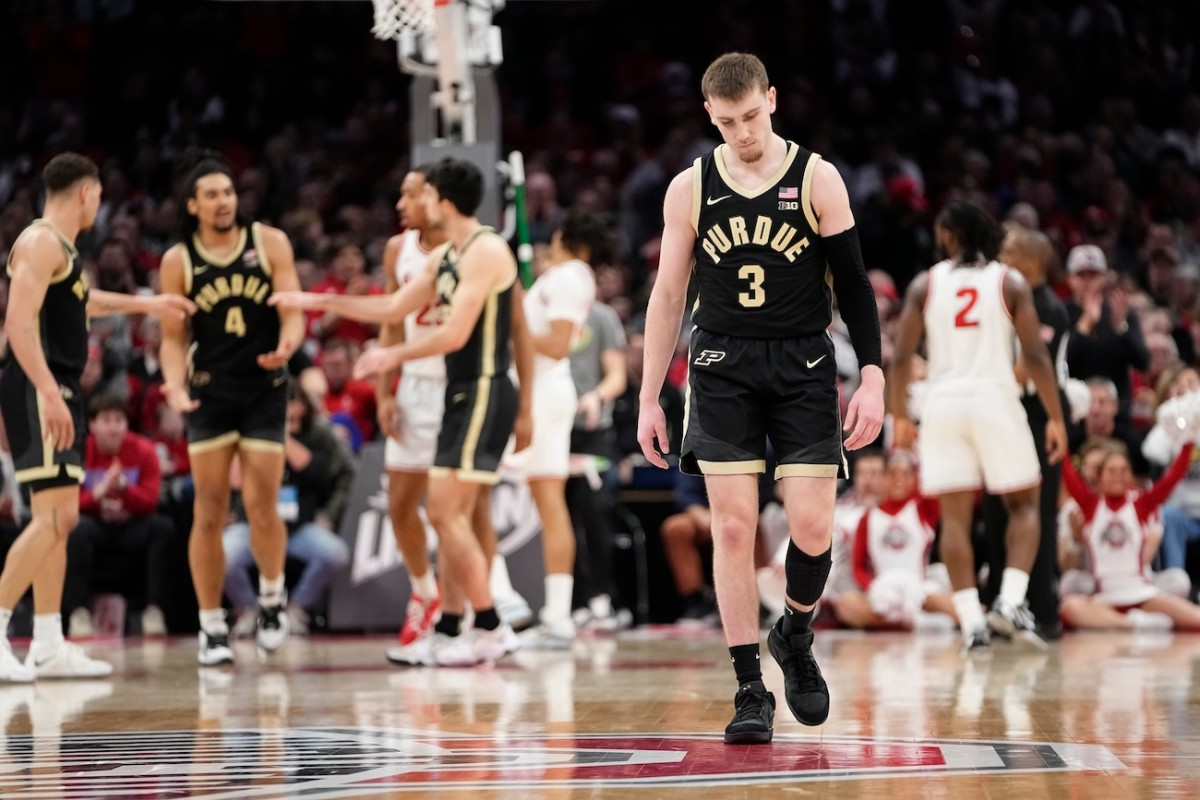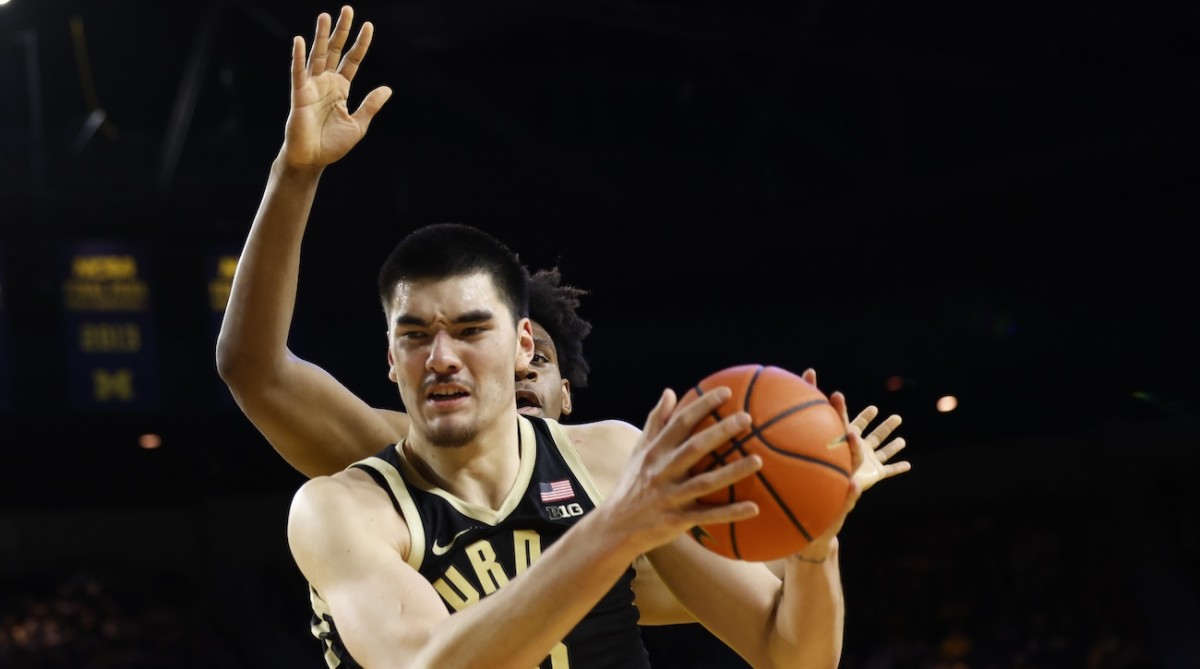Welcome to the Month of Purdue: How the Boilermakers Can Vanquish Past March Disappointments

It’s March. Welcome to the Month of Purdue.
There are, as always, many compelling story lines when men’s college basketball flips the calendar to its signature month. But none carries the psychological payload of the Boilermakers and their burden/opportunity as they seek to rewrite a sad narrative.
If you want a glimpse into No. 2 Purdue’s mindset at this point, here’s an anecdote from last week. After the Boilers hung 96 points on the Rutgers Scarlet Knights in a dazzling offensive performance, a reporter asked sophomore point guard Braden Smith what it means to him to be one of just 30 players nationally named to the Naismith Trophy midseason team.
“Nothing,” Smith responds quickly. “I’m not just saying that. I just want to win. That’s what’s on my mind after what happened last year.”

Smith brought it up voluntarily: what happened last year. It was a continuation of what had happened in previous years, only worse. It was rock bottom. It was No. 16 seed Fairleigh Dickinson 63, No. 1 Purdue 58, in the first round of the NCAA tournament.
The Knights from Teaneck, N.J., were arguably the worst team in history to win a game in the tourney main bracket, which makes the Boilermakers the perpetrators of arguably the biggest choke in March Madness history. That is the sum total of Smith’s Purdue purview, but the legacy of Boilermaker heartbreak stretches back far longer.
The FDU disaster followed other recent NCAA tournament flameouts under Matt Painter, against the No. 15 seed Saint Peter’s Peacocks (2022), No. 13 North Texas Mean Green (’21) and No. 12 Little Rock Trojans (’16). All told, a program that has been consistently very good for about a century is working on a 44-year streak without a Final Four appearance.
Now, Purdue is trying to go from 2023 nadir to ’24 zenith before its championship window narrows with the departure of 7' 4" Zach Edey, the National Player of the Year last season and likely this season as well. He will leave as the school’s all-time leading rebounder and probably its leading scorer as well, depending how far this team progresses. The scar tissue from last season is visible, as is the urgency to heal it this year.
Which is why, to Smith’s point, none of the trappings of another wildly successful regular season resonate much with the Boilers. Individual accolades can be appreciated later. An undefeated November doesn’t matter. A 5–1 December, with victories over the Arizona Wildcats and Alabama Crimson Tide, doesn’t matter. Same with an 8–1 January and a 5–1 February, which put Purdue in position to claim a second straight Big Ten regular-season title with three games to go.
March is all that matters. Specifically, everything that happens from March 22 onward. That’s the date for first-round games in Indianapolis, the site where Purdue is a virtual lock to be assigned as a No. 1 seed. (This will all become official on Selection Sunday, March 17.)
The Boilermakers will have a huge fan presence for a virtual home game against a No. 16 seed. They simply have to avoid the catastrophe of 2023 and Marches prior to that. They’re abundantly capable; it just has to happen.
In attempting to pull a 2019 Virginia Cavaliers by going from first-round humiliation to national champion, Purdue has reasons to believe this year will be different. For starters, it’s almost impossible to repeat last year’s catastrophe.
In defiance of basketball physics and rationale, the literal shortest of 363 Division I teams somehow beat a team with a 7'4" star center. Fairleigh Dickinson didn’t have anyone taller than 6'6", and the Knights’ top two players in terms of minutes against Purdue were 5'8" (Demetre Roberts) and 5'9" (Grant Singleton). Yet this band of Lilliputians held Edey scoreless for the final 8½ minutes, as the Boilermakers slid nightmarishly from one point up to five down at the buzzer. Purdue’s well-conceived, well-constructed, well-oiled offense seized up and shut down, buckling under the weight of a season going awry.
Now, though, the three most important Boilermakers are wiser and better players. That starts with Edey—“Zachary,” as Painter is fond of calling him—who is having an even better 2024 season than he had in ’23.

He’s playing slightly less than last season (down about one minute per game) while scoring slightly more (up from 22.3 to 23.7). His shooting percentage has improved from 60.7 to 62.7, and there have been small gains in assists, blocks and steals and a small reduction in turnovers. Most significantly, Edey is performing better against Big Ten opponents than he did in nonconference play, with almost all production going up.
Painter has recruited and developed a lot of big men. But the Canadian who didn’t spend much time with a basketball in his huge hands growing up has become the best he’s ever coached.
“He’s very intelligent and understanding of who he is,” Painter says. “Just a smart guy. There’s so much crap that goes on with recruiting—you feel bad for young kids. They’re put on a pedestal and they go and play college basketball and people are like, ‘Well, he’s not all that.’ Well, he’s young. He’s 18, 19 years old, playing against 22-year-olds.
“[Edey] doesn’t have any of that [inflated early expectations]. When he was 15 years old, he didn’t play organized basketball. That’s such a big piece where, if you tell him something, it’s not a fight. He’s just a selfless person, he’s a good guy.”
Painter’s task, now, is to bring Edey’s career a March climax. He’s pushing his big man to be the most dominant version of himself yet.
“As a coach, you always want more,” Painter says. “You don’t want more from somebody who plays six minutes and is your ninth man—it’s not fair. But when you’re dealing with someone who’s special like that, you’ve got to keep pushing them, keep grinding. Because they have the capabilities of carrying you on a given night.”
Edey is the literal largest part of Purdue’s March equation, but figuratively not the biggest. That is the Boilermakers’ guard play. The addition of Southern Illinois Salukis transfer Lance Jones has helped significantly, but it’s the two holdover starters from last season who will be the keys to March absolution. Smith and running mate Fletcher Loyer were freshmen who played like freshmen in the Fairleigh Dickinson debacle; both have grown up appreciably since then.
Loyer’s play has become less dependent upon seeing the ball go in the basket—he’s guarding better and demonstrating better shot selection. While overall scoring is down slightly (11 points per game to 10.1), the narrowly built sophomore has improved his three-point percentage from 33% to 40%. (That said, Painter would welcome a reversal of Loyer’s perimeter shooting in February, when he made just 2 of 12 threes.)
Smith’s performance against Fairleigh Dickinson was acutely painful: 2 for 10 from the field, a career-high seven turnovers and some defensive shortcomings. If you want a historical comparison, it was the Duke Blue Devils’ Bobby Hurley against the UNLV Runnin’ Rebels in the 1990 national title game. Hurley finished a great freshman season with a nightmare game, missing all three of his shots and turning the ball over five times in a blowout loss.
Then Hurley came back better as a sophomore, eventually turning the tables against UNLV in the national semifinals and helping Duke win the national championship. Smith’s sophomore season has been excellent—he’s averaging 12.7 points, 5.8 rebounds and 7.3 assists—and now he just needs to carry that over to March.
“This time last year was really tough for those two guys, and they’re doing a much better job,” Painter says. “It’s when adversity sets in that you see the difference. They want it all, and sometimes you can’t get it all, all the time. You have to slowly build on it. Fortunate to have them in our program.”
It’s Purdue’s month for as long as they can stay in it. If they’re still playing in April, a great many black-and-gold ghosts will have been exorcized.
